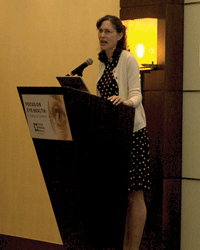The fight to prevent vision loss in America is still raging, as evident in the 2012 “Vision Problems in the U.S.” report. The vision update was presented to a packed house at the Focus on Eye Health Summit held on June 20 in Washington. This year’s audience included patient advocates, community-based organizations, national vision and eye health organizations, government agencies and policymakers. The Summit presented updated findings on the impact of adult eye disorders, visual impairment and blindness on the U.S. economy.

Ann Albright, Ph.D., R.D., director of the CDC’s Division of Diabetes Translation, gave the keynote address at this year’s Focus on Eye Health Summit.
The number of people age 40 and older with vision impairment and blindness has increased 23% since 2000, according to the study conducted by researchers at Johns Hopkins University. “It’s no surprise that the numbers of those affected by eye disease are continuing to climb, especially due to the aging baby boomer population,” said Hugh R. Parry, president and chief executive officer of Prevent Blindness America. “What is exceptionally concerning is the dramatic spike in diabetic retinopathy cases, a consequence of the diabetes epidemic that this country is experiencing with no end in sight.”
Diabetic retinopathy is the leading cause of new blindness in adults ages 20 to 74, and costs the United States about $500 million annually. So, it’s no surprise that the Summit’s keynote address focused on diabetes and the eye. Keynote speaker Ann Albright, Ph.D., R.D., director of the Division of Diabetes Translation at the Centers for Disease Control and Prevention, reminded the audience of how integral eye-care professionals are to the mission to eradicate diabetes. Although there is no cure for diabetic eye disease, annual eye exams for diabetes patients are essential to help slow disease progression.
As someone who has lived with type 1 diabetes for 44 years, diabetes prevention and treatment is a major part of Dr. Albright’s personal and professional life. She noted that vision loss in diabetes patients was down 26% from 1997 to 2009. “We’re doing some things right,” Dr. Alright said. “Fewer people are having vision loss, except that the absolute number of people is so large that we’re overtaking the gains that we’re making in those improvements. We can’t quit now. We’ve got a long ways to go.”
She said the approach must be two-pronged: prevention and control. Proactive measures could considerably reduce the staggering number of new cases of diabetes, while proper monitoring and control can minimize the number of complications.
Currently, one in 10 U.S. adults has diabetes, but if trends continue, one in three U.S. adults will have diabetes by 2050, she said. “We think we have an issue with diabetes now—it’s going to get worse if things stay on the trajectory that we’re on,” Dr. Albright added. “And I think that’s really the good news for all of us. It does not have to stay on the trajectory that it’s on. In fact, it can’t stay on the trajectory that it’s on. This is unsustainable.”
| Eye Disease is on the Rise in America
|
|
Released by Prevent Blindness America and the National Eye Institute, the 2012 “Vision Problems in the U.S.” report highlighted some alarming statistics about increases in the four most common eye diseases since 2000:
All data from the “Vision Problems in the U.S.” report can now be
obtained through a new searchable database housed on the Prevent
Blindness America website located at
|

